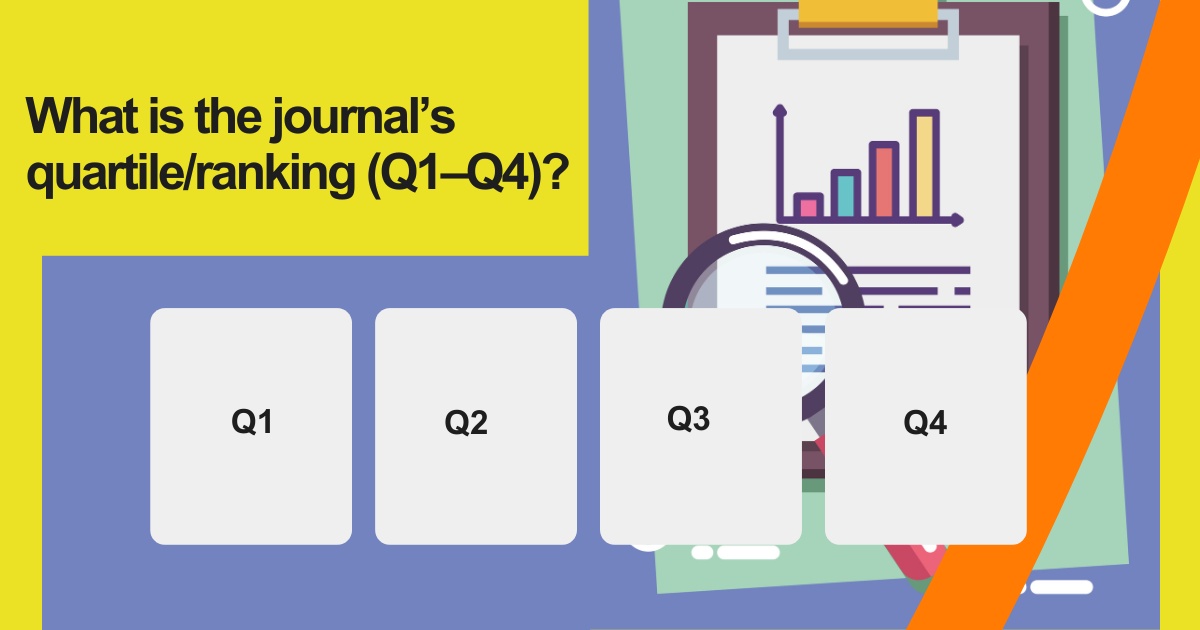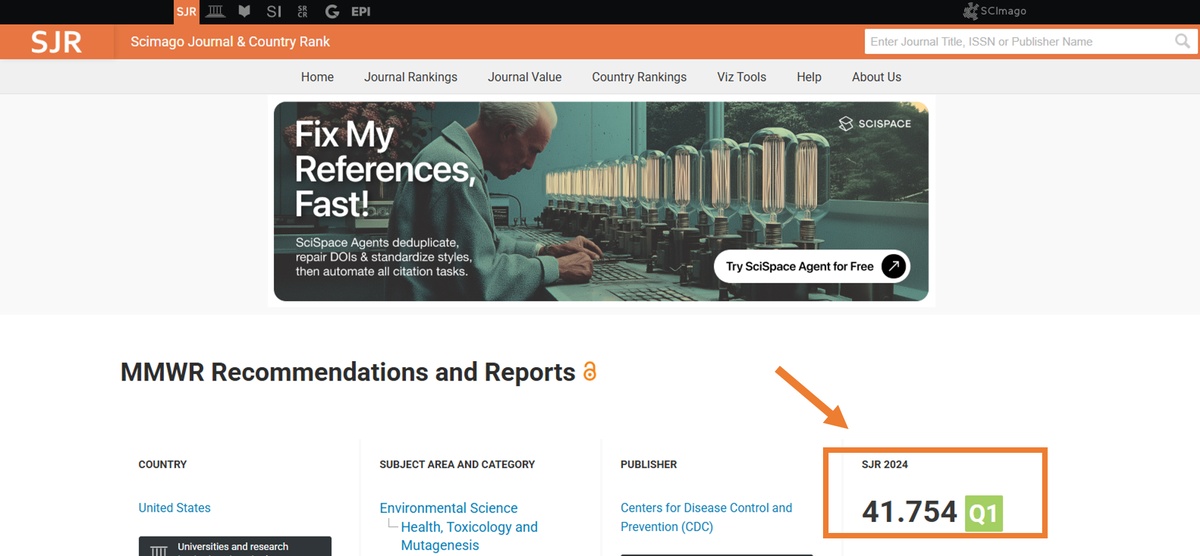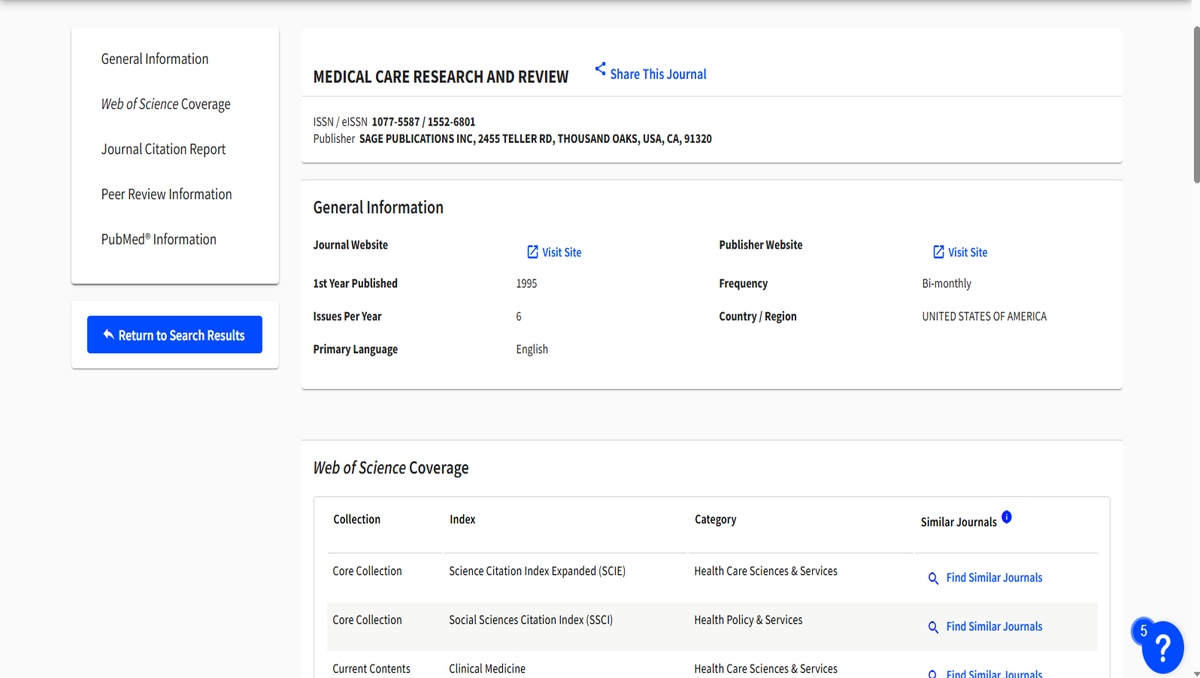What is the journal’s quartile/ranking (Q1–Q4)?


For researchers, professors preparing for academic promotion, and postgraduate students aiming to publish internationally, understanding journal quartile rankings (Q1–Q4) is essential. Promotion committees, funding bodies, and university research offices often evaluate your research based on where you published, not just how many papers you produced.
Despite how frequently quartiles are discussed, there is widespread confusion about how they are calculated and where to verify them. Many researchers mistakenly assume that quartiles are shown directly on Scopus—when in fact, Scopus does not display quartile rankings at all.
This article provides a practical, step-by-step explanation of journal quartiles in Scopus (via SJR) and Web of Science (via JCR), including common misconceptions and how quartiles affect academic promotion and tenure evaluations.
Quartiles divide journals into four groups based on how their citation performance compares to others in the same academic field. These groups reflect the journal’s influence, visibility, and citation impact.

Q1 (Top 25%) → Highest-impact journals in a subject category
Q2 (25–50%) → Well-ranked, above-average journals
Q3 (50–75%) → Mid-tier journals
Q4 (75–100%) → Lower-ranked but still indexed journals
A journal can be:
Q1 in “Education”
Q2 in “Sociology”
Q3 in “Cultural Studies”
This is normal because ranking depends on journal performance within each subject category, not the entire database.
 Many researchers incorrectly say “Scopus Quartile,” but technically:
Many researchers incorrectly say “Scopus Quartile,” but technically:
Scopus DOES NOT show quartiles.
Quartiles come from:
✔ SJR (Scimago Journal Rank)
which uses Scopus citation data.
SJR score
Citation influence
Subject category ranking
Citation prestige (weighted citations)
Journals in each subject category are divided into:
Q1 → Top 25%
Q2 → 25–50%
Q3 → 50–75%
Q4 → 75–100%
This is why universities often accept SJR Q1/Q2/Q3/Q4 as “Scopus quartiles.”
But researchers must understand:
Scopus Sources = indexing status + CiteScore
SJR = quartiles + SJR score + category ranking
Both are useful—but for different purposes.
Since Scopus does not show quartiles, the correct method is via Scimago Journal Rank (SJR).
Go to:
https://www.scimagojr.com
Completely free and publicly accessible.
You can search by:
Journal name
ISSN
Subject area
Country
You will see:
SJR Score
H-index
Total documents and citations
Subject categories
Quartiles (Q1–Q4) by category
This is the ONLY place to see Scopus-based quartiles.
Each subject category will show its quartile:
Example:
Category | Quartile |
|---|---|
Education | Q1 |
Sociology | Q2 |
Cultural Studies | Q3 |
Different categories = different quartiles.
Although SJR uses Scopus data, not all SJR-listed journals are currently active in Scopus.
To verify indexing:
Visit https://www.scopus.com/sources
This confirms:
Active coverage
Discontinued journals
Inclusion/exclusion year
SJR = quartile
Scopus.com = indexing status
Researchers must check both.
Web of Science quartiles come from Journal Citation Reports (JCR) by Clarivate.
Quartiles depend on:
Journal Impact Factor (JIF) ranking
Subject category
Annual JCR update
Q1 → Top 25% of journals based on JIF
Q2 → Next 25%
Q3 → Next 25%
Q4 → Lowest 25%

Link:
https://jcr.clarivate.com
(usually requires institutional access)
You will see:
Impact Factor
JIF rank within each subject category
JCR quartile (Q1–Q4)
JCI (Journal Citation Indicator)
5-year Impact Factor
Example:
Category | Rank | Quartile |
|---|---|---|
Education | 32/268 | Q1 |
Social Sciences | 49/188 | Q2 |
Quartiles change every year with JCR updates.
Promotion committees require the latest quartile.
SCIE → Sciences → Quartile available
SSCI → Social Sciences → Quartile available
ESCI → Emerging Sources → No quartile
Many researchers are misled by publishers claiming fake Q1 status for ESCI journals.

No.
Quartiles come from SJR, not Scopus.com.
Not always.
Consider:
Scope match
Acceptance rate
Publication timeline
Field relevance
Promotion requirements
A well-targeted Q2/Q3 may serve your career better than a mismatched Q1.
They are independent.
A journal may be:
Q1 in SJR
Q2 in WoS
or vice versa.
False.
APC does not guarantee acceptance.
Incorrect:
ESCI journals → no quartiles
Some Scopus journals → not listed in SJR categories
New journals → no quartiles for first years
Different metrics entirely.
CiteScore = Scopus metric
SJR = Prestige-weighted citation metric
Quartiles = calculated on SJR, not CiteScore
Universities often require:
Minimum Q1/Q2 publications
Publications in indexed (Scopus/WoS) journals
Journals recognized by JCR or SJR
International visibility and citations
A strong quartile record strengthens:
Academic CV
Promotion applications
Grant proposals
Research reputation


SITA Academy offers practical, fast, and reliable support for researchers who want to publish in reputable Q1–Q4 journals and strengthen their academic profile.
We identify authentic Scopus (SJR) and WoS (JCR) quartile journals suitable for your field and goals. We help with journal matching, submission preparation, cover letters, and complete publication support.
We format your manuscript according to journal guidelines and assist with the entire submission process.
Professional academic editing to improve clarity, correctness, and publication readiness—trusted by researchers preparing for promotion and international submission.
We detect and reduce similarity using ethical rewriting strategies to meet journal originality standards.
We convert your master’s or PhD thesis into multiple publishable articles, helping you build a strong publication portfolio quickly.
If you’re preparing for promotion or pursuing high-quality publications, we help you choose the best journal and navigate the submission process smoothly.
Understanding journal quartiles (Q1–Q4) is essential for publishing strategically and meeting academic promotion standards. Whether you're targeting Q1 for maximum impact or selecting a well-matched Q2/Q3 to improve acceptance chances, what matters most is choosing a journal aligned with your research and institutional expectations.
If you have any questions, inquiries, or would like to learn more about our services, please don't hesitate to reach out to us. Our dedicated team is ready to assist you.